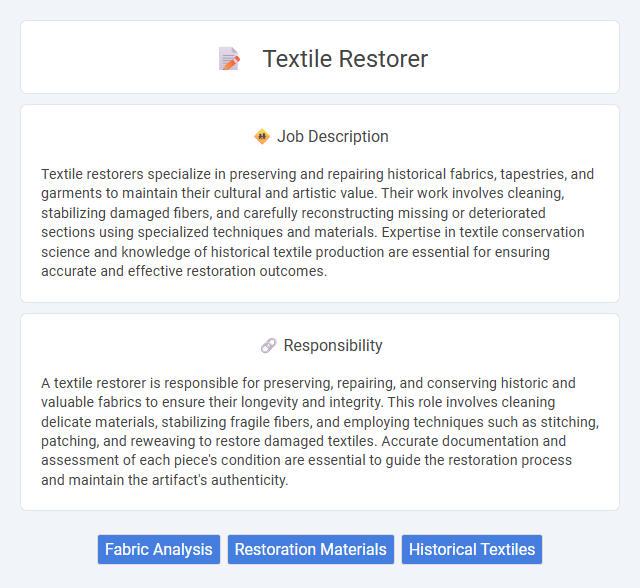
Textile restorers specialize in preserving and repairing historical fabrics, tapestries, and garments to maintain their cultural and artistic value. Their work involves cleaning, stabilizing damaged fibers, and carefully reconstructing missing or deteriorated sections using specialized techniques and materials. Expertise in textile conservation science and knowledge of historical textile production are essential for ensuring accurate and effective restoration outcomes.
Individuals with strong attention to detail and a passion for historical preservation are likely suitable for a textile restorer position. Those who prefer hands-on, meticulous work in controlled environments may find this role aligns well with their skills and interests. People who struggle with patience or fine motor tasks might find this job challenging or less suitable.
Qualification
A textile restorer must possess a strong background in art conservation, typically holding a degree in textile conservation, fine arts, or a related field. Expertise in fiber analysis, historical fabric techniques, and preservation methods is essential for accurately restoring and maintaining antique textiles. Proficiency with conservation tools, attention to detail, and knowledge of environmental factors affecting textile longevity are critical qualifications for this specialized role.
Responsibility
A textile restorer is responsible for preserving, repairing, and conserving historic and valuable fabrics to ensure their longevity and integrity. This role involves cleaning delicate materials, stabilizing fragile fibers, and employing techniques such as stitching, patching, and reweaving to restore damaged textiles. Accurate documentation and assessment of each piece's condition are essential to guide the restoration process and maintain the artifact's authenticity.
Benefit
Textile restorers likely contribute significantly to preserving valuable historical and cultural fabrics, ensuring their longevity for future generations. The role probably offers the benefit of working closely with art and history, which may enhance job satisfaction and intellectual engagement. Financially, the position may provide competitive salaries and opportunities for career advancement within museums or conservation organizations.
Challenge
Textile restorers likely face the challenge of accurately identifying and preserving delicate fabrics that have deteriorated over time. The probability of encountering unknown materials or unconventional damage complicates restoration methods, requiring specialized knowledge and meticulous techniques. Balancing the preservation of original integrity while preventing further decay often demands innovative solutions and constant problem-solving.
Career Advancement
Textile restorers specialize in conserving and repairing historical fabrics, utilizing advanced techniques to preserve cultural heritage. Career advancement often involves gaining expertise in fiber identification, chemical treatments, and textile history, leading to roles such as senior conservator or museum curator. Professional growth is supported by certifications from organizations like the American Institute for Conservation and opportunities to collaborate on high-profile restoration projects.
Key Terms
Fabric Analysis
Textile restorers specialize in fabric analysis to assess the condition, composition, and age of historic textiles, using techniques such as microscopy and fiber identification. Understanding the fabric's weave structure and dye components is essential for choosing appropriate conservation methods that prevent further degradation. Accurate fabric analysis ensures preservation of textile integrity while maintaining historical authenticity in restoration projects.
Restoration Materials
Textile restorers specialize in preserving and repairing historic or valuable fabrics using carefully selected restoration materials such as silk crepeline, Japanese tissue paper, and conservation-grade adhesives. These materials are chosen for their compatibility, reversibility, and minimal impact on the textile's original fibers and dyes. Precision tools and controlled environmental conditions ensure that restoration materials effectively stabilize delicate textiles while maintaining their historical integrity.
Historical Textiles
Textile restorers specializing in historical textiles preserve and repair delicate fabrics from museums, heritage sites, and private collections. They analyze fiber composition, weave patterns, and dye stability to apply appropriate cleaning, stabilization, and conservation techniques. Expertise in warping, stitching, and color matching ensures the longevity and authenticity of fragile antique garments and tapestries.
 kuljobs.com
kuljobs.com